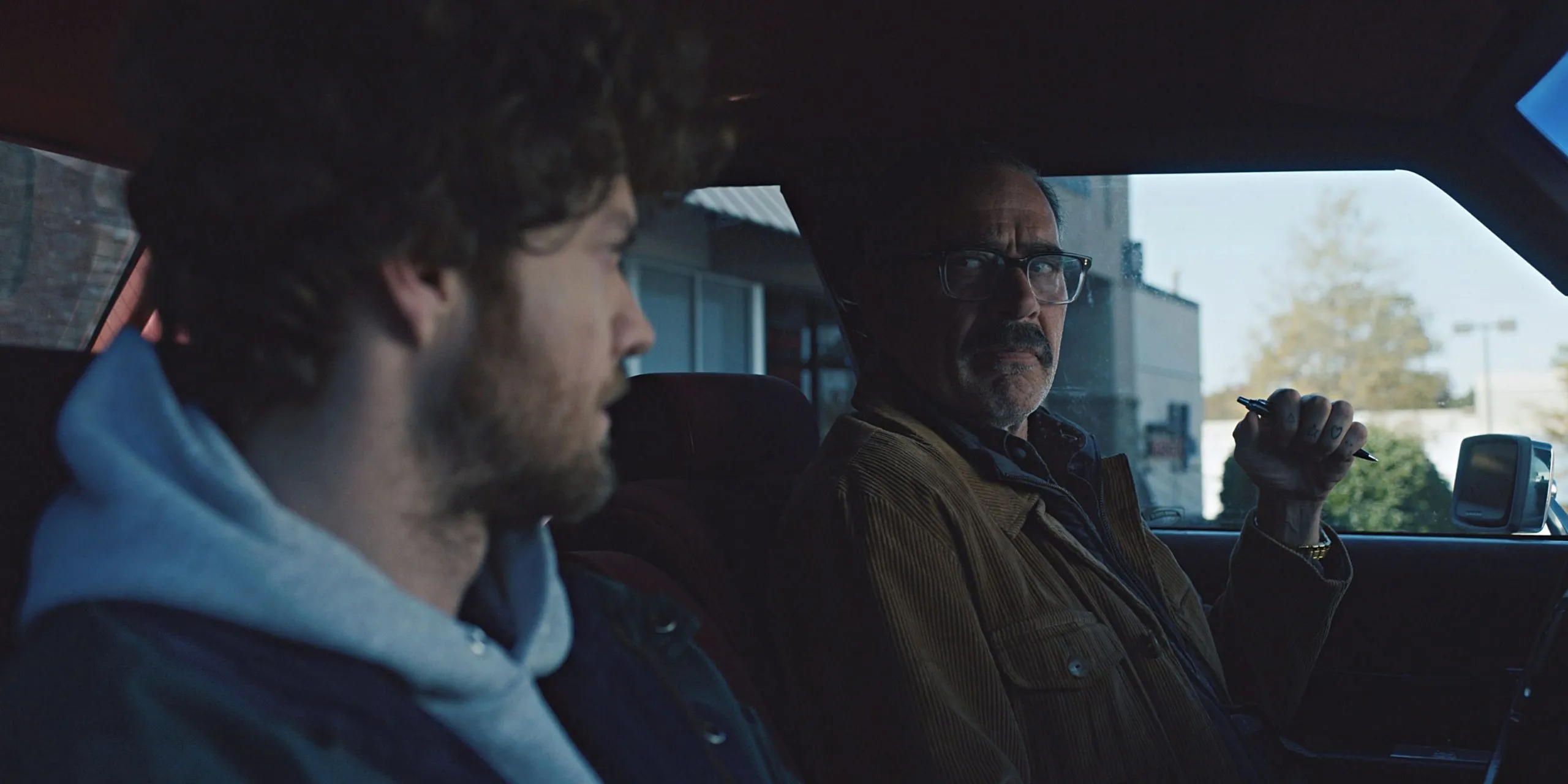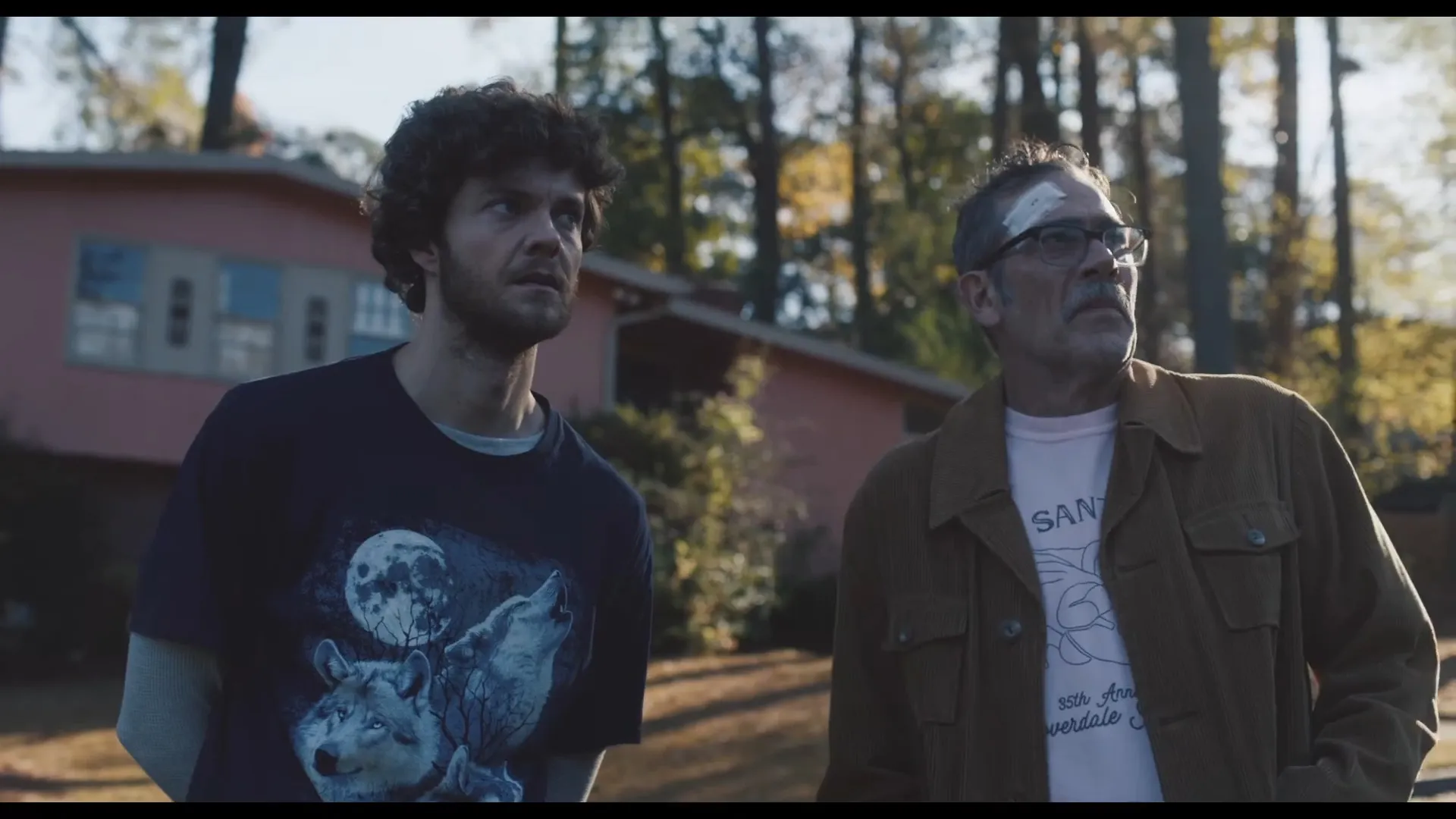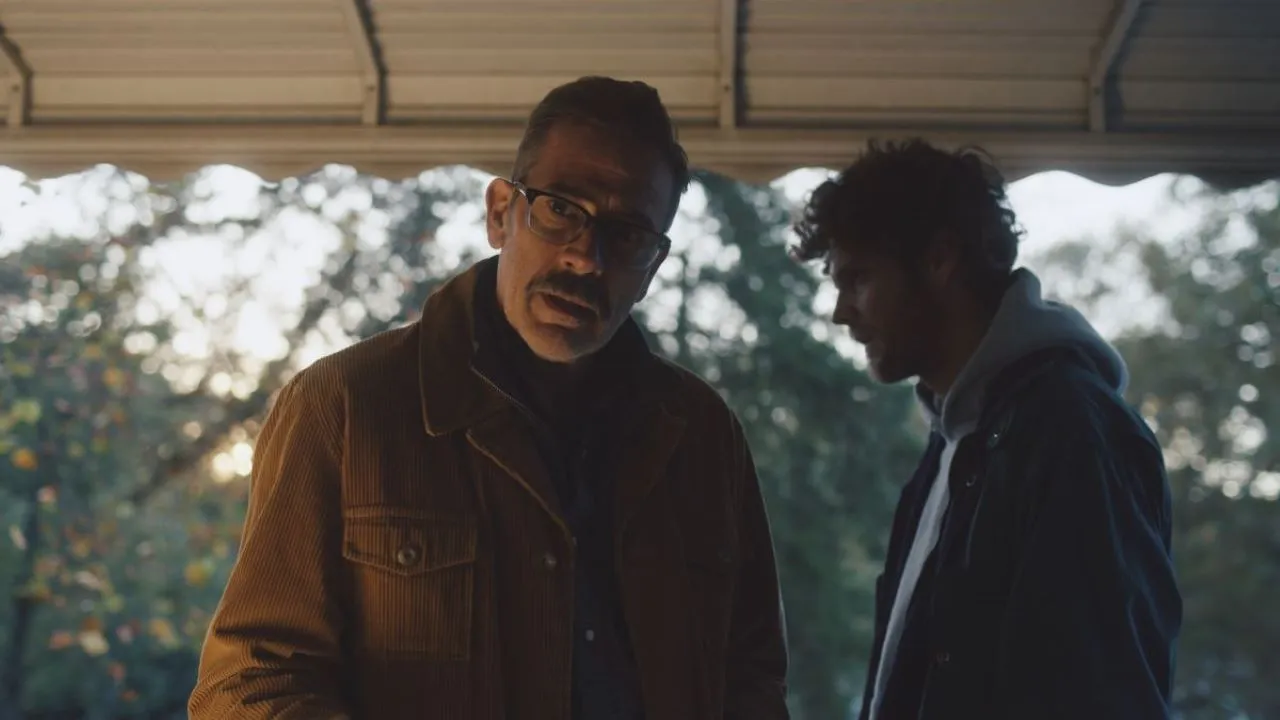This indie thriller marries hushed suspense with a streak of dark humor, following two damaged souls across a city slipping into neglect. Simon McNally (Jack Quaid), managed by medication and haunted by vivid visions, becomes the sole witness to a daylight abduction.
His pleas to Detective Glover fall on deaf ears, leaving him stranded on the edge of disbelief. He turns to Ed Deerman (Jeffrey Dean Morgan), a retired security guard with a roving temper and a decorated past, who reluctantly agrees to help.
Set against the peeling facades of Birmingham, Alabama, every boarded-up storefront and rusted fence mirrors the internal outposts these men occupy: isolation, regret and a stubborn hunger for redemption. DeeDee (Malin Åkerman), Simon’s sister and caregiver, anchors his reality with compassion and unspoken fear.
Alone, Simon’s reality trembles; paired with Ed, his fractured perception finds new angles. The true magnet here lies in that alliance: two outsiders, bound by scars, forging a pact to save a stranger—and perhaps salvage their own fragile selves.
Architecture of Suspicion
Simon McNally inhabits a world poised between gritty reality and whispered hallucination. His mornings blur into failed job interviews, each brusque dismissal sharpening the ache of isolation. In muted apartment halls, pills rattle like reluctant prayers while DeeDee—his sister and anchor—moves through the routine of nursing school and late-night support. Across the street, Ed Deerman nurses his own brand of solitude: a retired security guard clinging to old badges of purpose, his poker losses echoing like confessions of regret.
The spark arrives in broad daylight. Simon stumbles on a young woman hauled into a white van and, with trembling fingers, captures a license plate. When uniformed skepticism greets him, his history of institutional stays and a violent record becomes proof against belief. That rejection casts him toward Ed, whose initial sneer at Simon’s “screw-loose” reputation gives way to curiosity.
Their alliance takes shape in rain-slicked alleys and flickering streetlamps. Simon’s meticulous sketches of apartment layouts fuse with Ed’s garbled recollections of campus routes. Surveillance stills yield cryptic clues while hesitant witnesses offer half-heard confessions. At each turn, a tremor ripples through Simon’s mind—sonic whispers and shifting shadows—forcing Ed to confront the limits of his own prejudice.
Midway, a breakthrough jars their fragile trust. A name emerges, pointing toward an abandoned textile mill on Birmingham’s outskirts. Yet when they arrive, hope fractures: a false lead, a secret withheld by an unexpected ally. Ed’s temper flares while Simon’s inner voices rise, and the investigation teeters on collapse.
In the charged stillness of the climax, decoded clues converge on a derelict warehouse. A single gunshot cuts through the hush, rattling rooftop water tanks. Ed lunges as Simon, heart hammering, inches forward with trembling resolve. Bloodied hands and adrenaline fuse into action.
Dawn finds them on an empty overpass, the rescued woman safe at their backs. Simon and Ed stand side by side, shadows stretching toward the city they’ve both seen crumble. Their silhouettes, tightened by shared risk, step off into uncertain light.
Faces on the Fringe
Simon McNally unfolds as a study in fractured perception. Jack Quaid embodies schizophrenia with jagged precision: pulsing hallucinations materialize in sudden camera cuts, while a ragged inner voice—embodied by a looming red figure—murmurs corrosive doubts. His dialogue lurches into “word salads,” each misstep in conversation underscoring an urgent need to be heard. Quaid’s posture shifts from hunched withdrawal to taut alertness, every restless foot-tap a call for validation amid a world that refuses to believe him.
Opposite Simon stands Ed Deerman, a man wearing bitterness like armor. Jeffrey Dean Morgan settles into the role with gravelly authority, hurling misogynistic barbs and revealing a compulsive poker habit that doubles as a confession of lost identity.
Yet glimmers of vulnerability surface in quiet moments: the flicker of regret as he studies Simon’s trembling frame, or the hesitant grip on a discarded security badge. Their banter crackles, charged by tension and tempered by unexpected warmth, mapping a friendship built on necessity and flickers of trust.
DeeDee McNally anchors Simon’s reality with a gentle firmness. Malin Åkerman crafts her as equal parts caregiver and sister, alternating soft reassurance with fierce protectiveness. In scenes recalling Simon’s institutional past, her eyes carry unspoken fear and unwavering resolve. Those flashbacks ripple through the present, reminding that memory can both wound and sustain.
Detective Glover and peripheral figures serve as structural pressure. Their clipped refusals and sidelong glances dramatize systemic bias, every dismissive gesture reinforcing Simon’s outsider status. Brief cameos—a neighbor who spots a clue, a hospital aide who sighs at bureaucracy—extend the world beyond the two leads, each performance sharpening the film’s critique of authority.
And then there is the antagonist, largely unseen yet omnipresent. The kidnapper’s off-screen menace delivers its own gravity: unseen steps in dark alleys become more terrifying than any face revealed. This absence intensifies every beat of suspense, positioning the unknown as the film’s most insistent character.
Echoes in the Cracks
Neighborhood Watch stages its central relationship against a backdrop of dismissal and disbelief. Simon McNally’s desperate bid for truth cracks open the stigma surrounding mental illness: each raised eyebrow, every clipped reply from authorities, underscores a culture quick to label and slow to listen. His hallucinations—fragmented voices and the looming red figure—become not mere spectacle but an urgent language, demanding recognition where none is offered.
Ed Deerman’s first response echoes society’s reflexive prejudice. His curt refusals and sarcastic quips mirror a public that views mental health through the lens of fear and misunderstanding. Yet as their uneasy alliance deepens, a platonic bond emerges, sidestepping familiar tropes of rescue or pity. Patience becomes Ed’s lesson; resolve becomes Simon’s inheritance. The two men trade strengths, forging a fragile solidarity that transcends decades of isolation and error.
Confrontations with Ed’s own intolerance surface as acts of redemption. When misogynistic jabs fall away in the face of Simon’s humanity, that shift feels earned rather than scripted. Simon’s willingness to extend trust to a neighbor who once shrugged him off epitomizes a leap that few films enact without sentimentality.
Moments of quiet triumph—a witness persuaded by Simon’s earnest gaze, a coded clue unveiled—mirror inner transformations. A once tight-lipped Ed offers a nod; Simon meets it with a steady stare. In that shared glance, action and emotion converge.
The city itself embodies their fractures. Birmingham’s boarded windows and overgrown lots stand in silent testament to lives left untended. Yet alongside crumbling brick, shafts of dawn light spill through broken panes, suggesting that reconstruction begins in small gestures—a clue followed, a hand extended, a wall finally breached.
Framing the Fractured City
Birmingham asserts itself as a silent protagonist, its boarded-up storefronts and overgrown lots tracing a narrative of neglect. Each alley and abandoned lot carries memory in crumbling brick, lending the film a sense of authenticity seldom achieved on soundstages. Real streets and local landmarks anchor the action, inviting the audience to inhabit a place where decay and hope collide.
Hand-held camera work dominates the chase and panic sequences, the jittery motion mirroring Simon’s rattled perception and Ed’s rapid heartbeat. In contrast, static wide shots capture Simon alone beneath a sodium-lit streetlamp, isolation rendered in harsh lines and deep shadows. This interplay of kinetic urgency and measured stillness shapes a visual rhythm that keeps empathy in tension.
Muted earth tones wash over exteriors, dusk and dawn light draping scenes in dusty gold or bruised purple. Hospital interiors snap to unflattering fluorescents, each flicker emphasizing Simon’s vulnerability. In Ed’s home, pockets of warm lamplight soften his rough edges, casting poker chips and vintage security gear in an almost reverent glow.
Production design extends character into space. Simon’s apartment stands sparse: framed snapshots of brighter days lean against peeling walls, pill bottles punctuating empty shelves. Ed’s garage tells a different story—surveillance monitors hum beside stacked uniforms, poker cards scattered like confessions on a battered workbench. Objects become shorthand for memory and regret.
Costume and props complete the portrait. Simon drifts through crowd scenes in a shapeless coat and muted slacks, blending into urban anonymity. Ed’s signature cap and utility belt conjure a lifetime of self-assigned authority, each buckle and crease suggesting battles fought long before this abduction. Together, these choices transform city and characters into a seamless visual tapestry.
Rhythms of Unease
Duncan Skiles orchestrates tension like a master conductor, letting scenes simmer before detonating sudden jolts. Quiet moments—Simon tracing license plates beneath flickering fluorescents—linger long enough for a hum of dread to gather. Then a poker chip spins across Ed’s cluttered table, landing with a sharp click that fractures the stillness.
Sean Farley’s screenplay thrives on clipped dialogue that mirrors Simon’s fractured mind. Conversations interrupt themselves, words tangle and trail off, delivering an authenticity that refuses polish. Subplots stay lean, so every clue glows. Even a brief back-hall exchange crackles with urgency, each line a building block of suspense.
The film’s pulse matches its characters’ frantic search. Early sequences drift through interpersonal textures before shifting to hand-held cameras that catch every stumble and gasp in pursuit of fragmented leads. Those rapid edits collide with static wide shots that trap Simon or Ed in empty streets, reminders of the solitary stakes they face.
Emotional peaks unfold with careful timing. Simon’s breakdown in a sterile hospital corridor lands like a punch, juxtaposed against Ed’s silent hesitation at the door. Act breaks close on half-lit hallways and fractured sound cues, ushering audiences into the next act with a pulse-quickening question.
Skiles tips his hat to classic odd-couple pairings of the ’80s, yet sidesteps formula. Banter feels off-kilter, humor emerges from discomfort instead of rehearsed beats, and the bond that develops here upends typical power dynamics. The result feels immediate, unvarnished, alive.
Resonant Frequencies and Fractured Frames
A sparse piano motif threads through Neighborhood Watch, its simple notes echoing Simon’s solitude and the tentative hope that flickers beneath his anxieties. In Ed’s living room, a crackling radio drifts between poker chip clacks, grounding the thriller in domestic reality even as suspense coils elsewhere. Those diegetic strains pivot sharply during a stakeout, where a distant guitar riff gives way to a sudden drumbeat, alerting both characters and audience to unseen danger.
Sound design blurs lines between perception and truth. Hallucination sequences swarm with layered whispers and distorted footsteps, each echo bending the air around Simon until silence itself feels ominous. Outside, ambient city noises—faraway sirens, a lone drip in a rain-soaked alley, wind rattling loose shutters—remind viewers that danger can lurk in the ordinary hum of urban decay.
Editing stitches together these audio textures with visual slashes that ripple into the psyche. Cross-cutting between Simon’s visions and the tangible world pulls belief into question: is that shadow real, or a trick of the mind? Montage sequences map the investigation’s heartbeat, weaving clue images—license plates, blurs of surveillance footage, torn flyers—into a kinetic tapestry that accelerates urgency without sacrificing clarity.
Abrupt sound cuts punctuate scenes of levity, letting Ed’s off-color quips ring out against sudden hushes for maximum sharpness. Action crescendos build on crescendos then snap back into calm, each oscillation keeping tension taut. In the climactic raid, lighting’s cold glint off metal and the staccato of gunfire land with visceral precision, uniting camera movement, score, and editing in relentless pursuit. Across every department, technical choices cohere around one aim: making each heartbeat feel exposed.
The Review
Neighborhood Watch
Neighborhood Watch navigates the fragile terrain of mental illness and social prejudice with uncompromising clarity. Jack Quaid and Jeffrey Dean Morgan anchor a taut thriller, their chemistry lending both grit and warmth to this decaying urban landscape. Duncan Skiles directs with assured restraint, layering suspense over genuine emotional stakes. Sparse score and immersive sound design heighten each revelation. Though framed in familiar buddy-thriller tropes, the film stakes a claim as a thoughtful study of trust and redemption.
PROS
- Jack Quaid and Jeffrey Dean Morgan deliver compelling chemistry
- Sensitive portrayal of schizophrenia woven into thriller framework
- Birmingham setting feels lived-in and atmospheric
- Sound design and sparse piano motifs reinforce tension
- Editing choices create immersive pacing
CONS
- Story occasionally follows familiar buddy-thriller beats
- A few narrative detours stall momentum
- Antagonist’s limited presence reduces emotional impact
- DeeDee’s character arc remains underexplored





















































